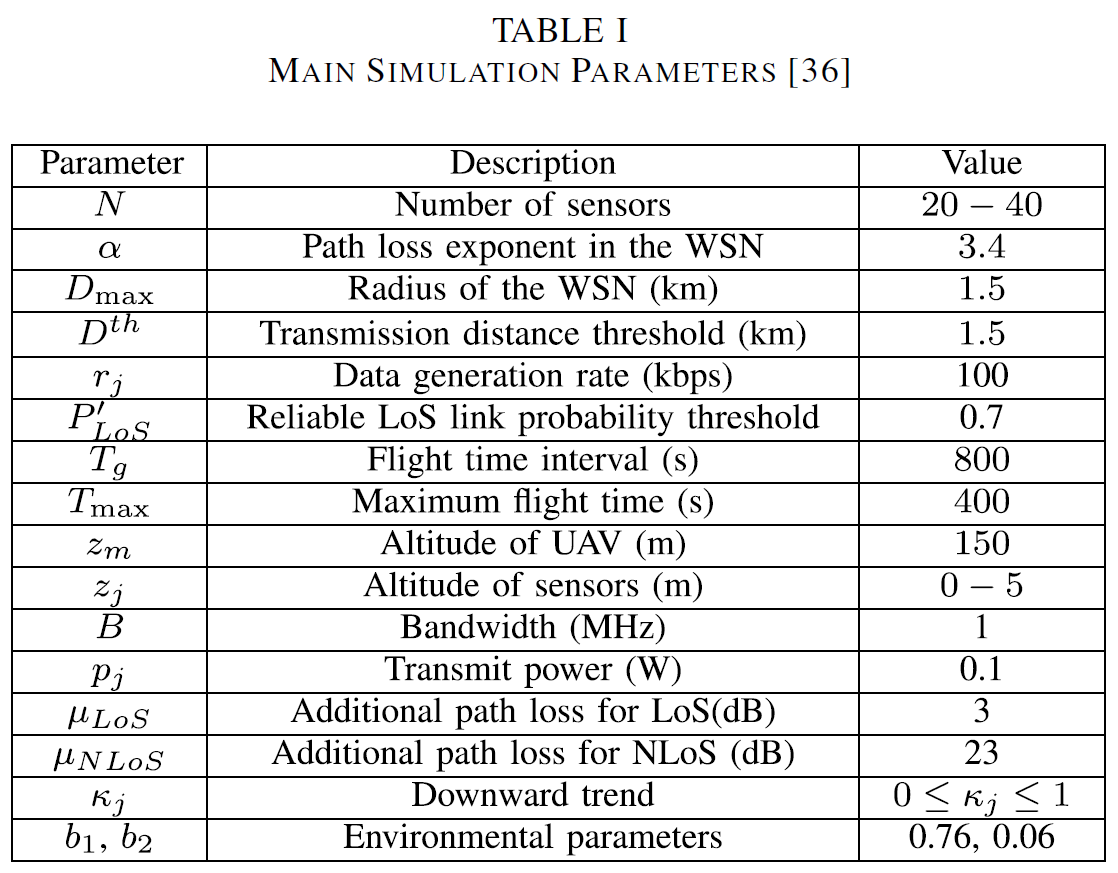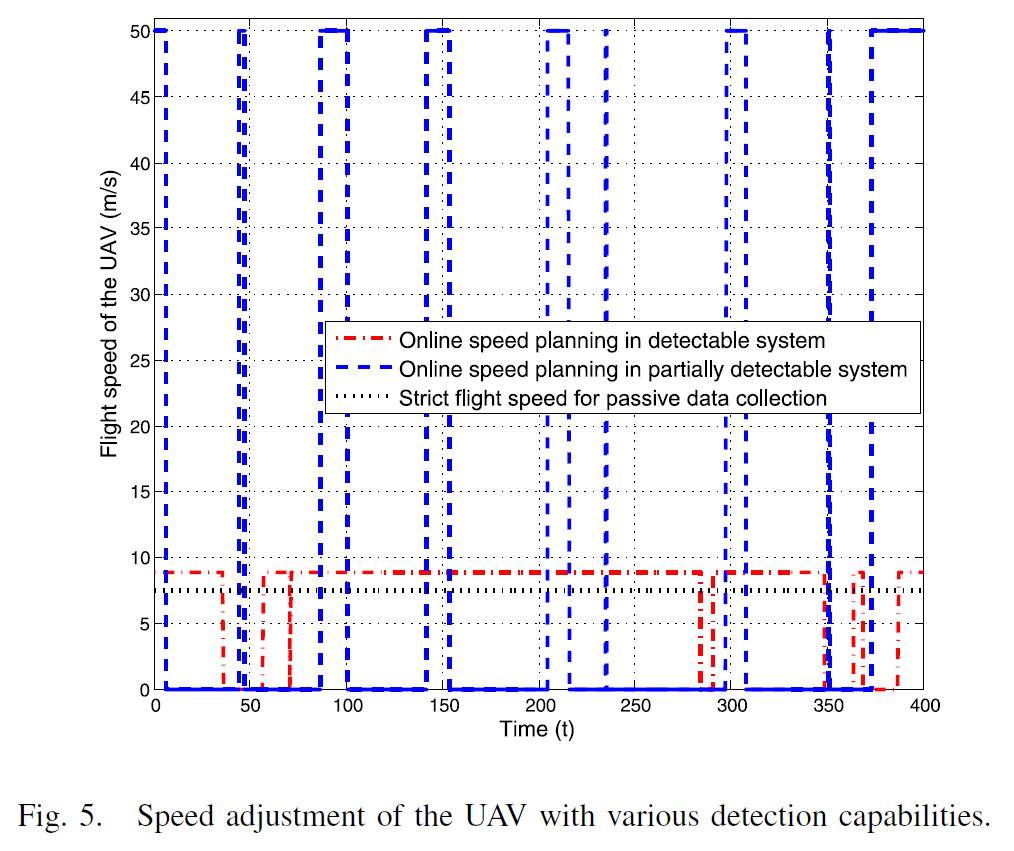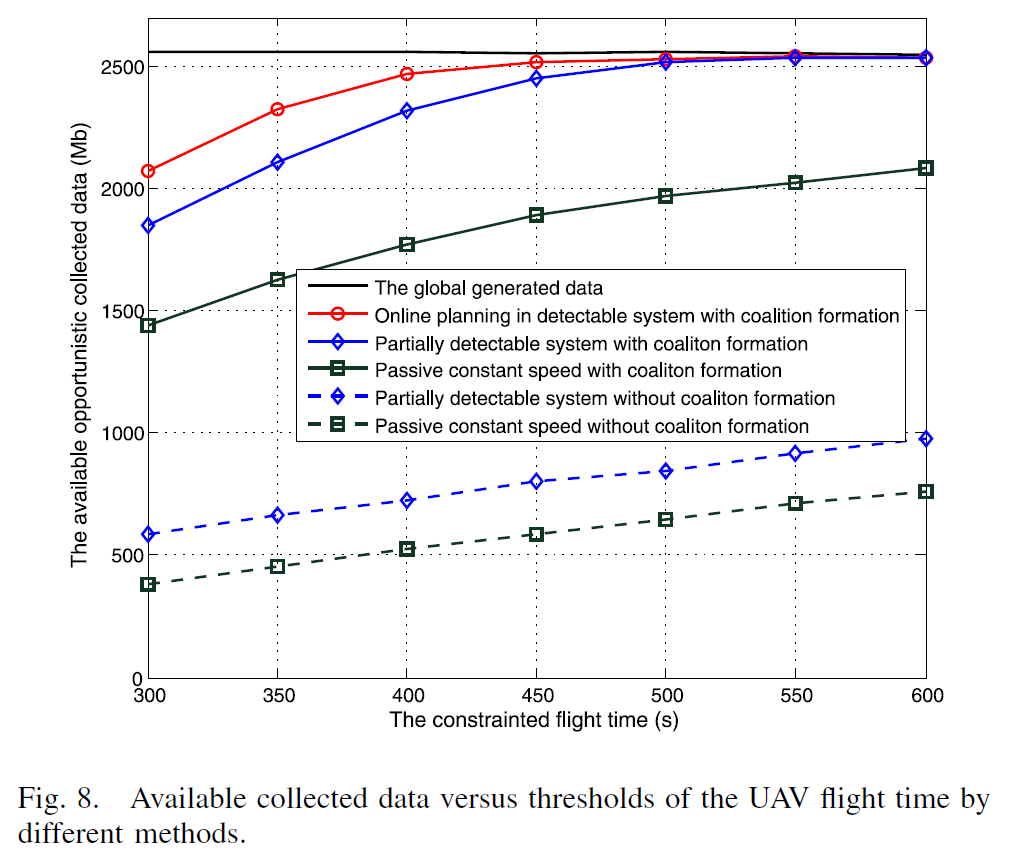Opportunistic Data Collection in Cognitive Wireless Sensor Networks - Air–Ground Collaborative Online Planning¶
source: https://ieeexplore.ieee.org/document/9103004
intro¶
- UAV: unmanned aerial vehicle
- WSN: wireless sensor networks
- deployed in remote areas for collecting data
- LoS: Line-of-Sight
- 兩點之間無障礙物
- NLoS: Non-Line-of-Sight
- 兩點之間有障礙物
- 靠 reflection
- past papers
- made some not-always-true assumptions
- dedicated UAV development
- UAVs are designed to collect data from WSNs to data centers
- optimally traverse all devices
- requires continuous dispatch of these specific UAVs
- data requirement already known
- state of WSN is also known
- so it won't work well in dynamic or unknown networks
- passive ground networks
- UAVs solve problems themselves, sensors just wait there and upload data when needed
- UAVs prevent transmission conflict with changing path & collecting data in sequence
- UAVs solve problems themselves, sensors just wait there and upload data when needed
- dedicated UAV development
- made some not-always-true assumptions
contribution of this paper¶
- studies the contrary of above assumptions
- oppurtunistic UAV data collection
- UAVs aren't specified to collect data, just that if they happen to pass by ground sensors, they can collect data
- during main task or when returning to base
- UAVs' main tasks may be patrol and surveillance
- don't need additional UAV placement to collect data from ground sensors
- UAVs aren't specified to collect data, just that if they happen to pass by ground sensors, they can collect data
- unknown characteristic of WSN
- limited coverage ability of UAV
- because those UAVs' main task aren't collecting data, so the flight path & coverage won't be optimal for collecting data
- oppurtunistic UAV data collection
- propose a distributed coalition formation algorithm
- coalition game for ground sensors clustering
- ground sensors form clusters → improve data upload efficiency of the whole WSN
- equilibrium based on Pareto criterion
- data upload protocol
- prevent transmission collision
- flight adjustment for UAV with different detection capabilities
- can converge
- coalition game for ground sensors clustering
system model¶
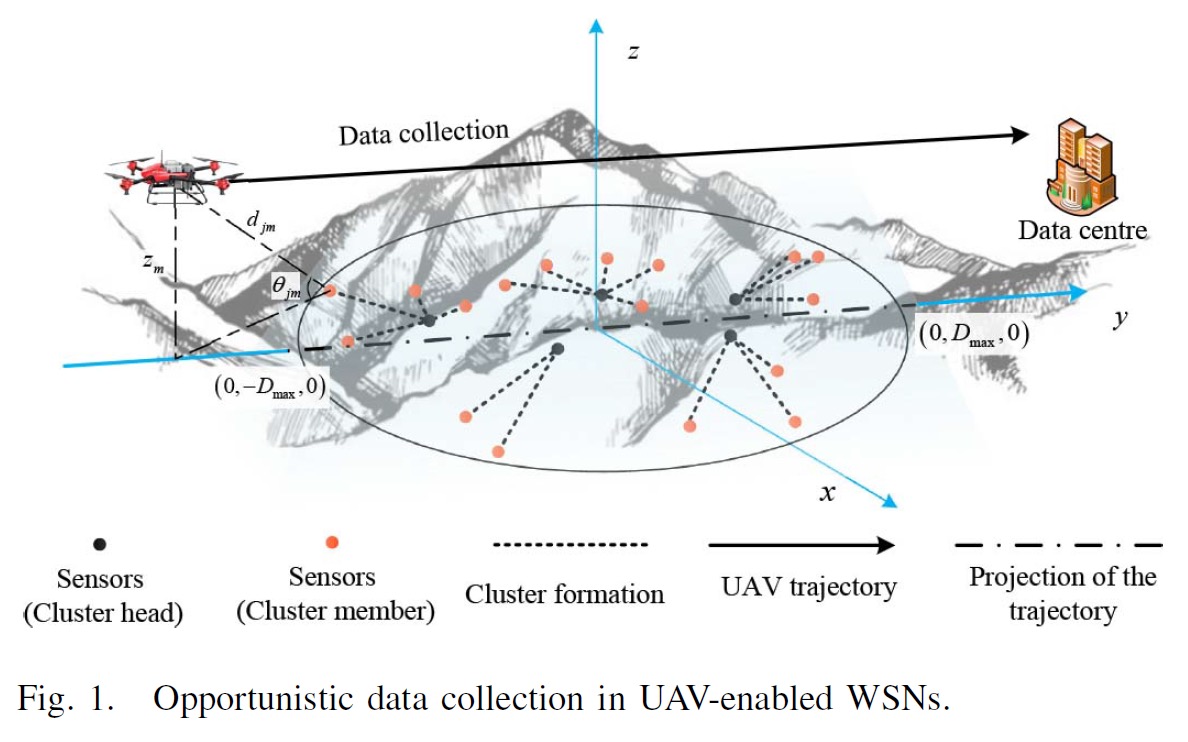
- WSN
- can't connect with ground control directly
- has a radius of \(D_{max}\)
- N sensor devices
- coordinate of sensor j = \(c_j\)=\((x_j, y_j, z_j)\)
- UAVs
- return to hq (to charge, update information etc.) periodically
- return one by one with interval \(T_g\)
- to avoid collision
- flies in straight line, enter WSNs at \((0,-D_{max})\), leaves at \((0,D_{max})\)
- coordinate of UAV m = \(c_m(t)\)=\((x_m, y_m(t), z_m)\)
- flying height \(z_m\) is fixed
- max flying time \(T_{max}<T_g\)
- energy & safety restrictions
- \(t\) = time after UAV enters WSN < \(t_{max}\)
- \(V_{max}\) = UAV's max flying velocity
- \(v_m\) = flying velocity < \(v_{max}\)

- \(t=0\) to \(T_{max}\) 總飛行距離超過兩倍 WSN radius
- limitation of \(T_{max}\) & \(v_{max}\) → flying energy is sufficient
- groud-to-air transmission
- LoS or NLoS
- different LoS probability for different sensor-UAV pairs due to uncertainty of blockade
- \(C_{jm}\) = transmission data rate between ground sensor \(j\) & UAV \(m\)

- \(B\) = channel bandwidth
- \(A_m(t)\) = num of sensors simultaneously uploading to UAV \(m\)
- compete resources
- \(\gamma_{jm}(t)\) = signal-to-noise ratio (SNR) between ground sensor \(j\) & UAV \(m\)
- obtained by many calculations
- communication among ground sensors
- only NLoS
- assume available channels of WSN is sufficient
- channel interference among sensors operating on same channel
- LoS or NLoS
problem formulation¶
min 的第一項是 transmission capacity,不可能超過
without clustering¶
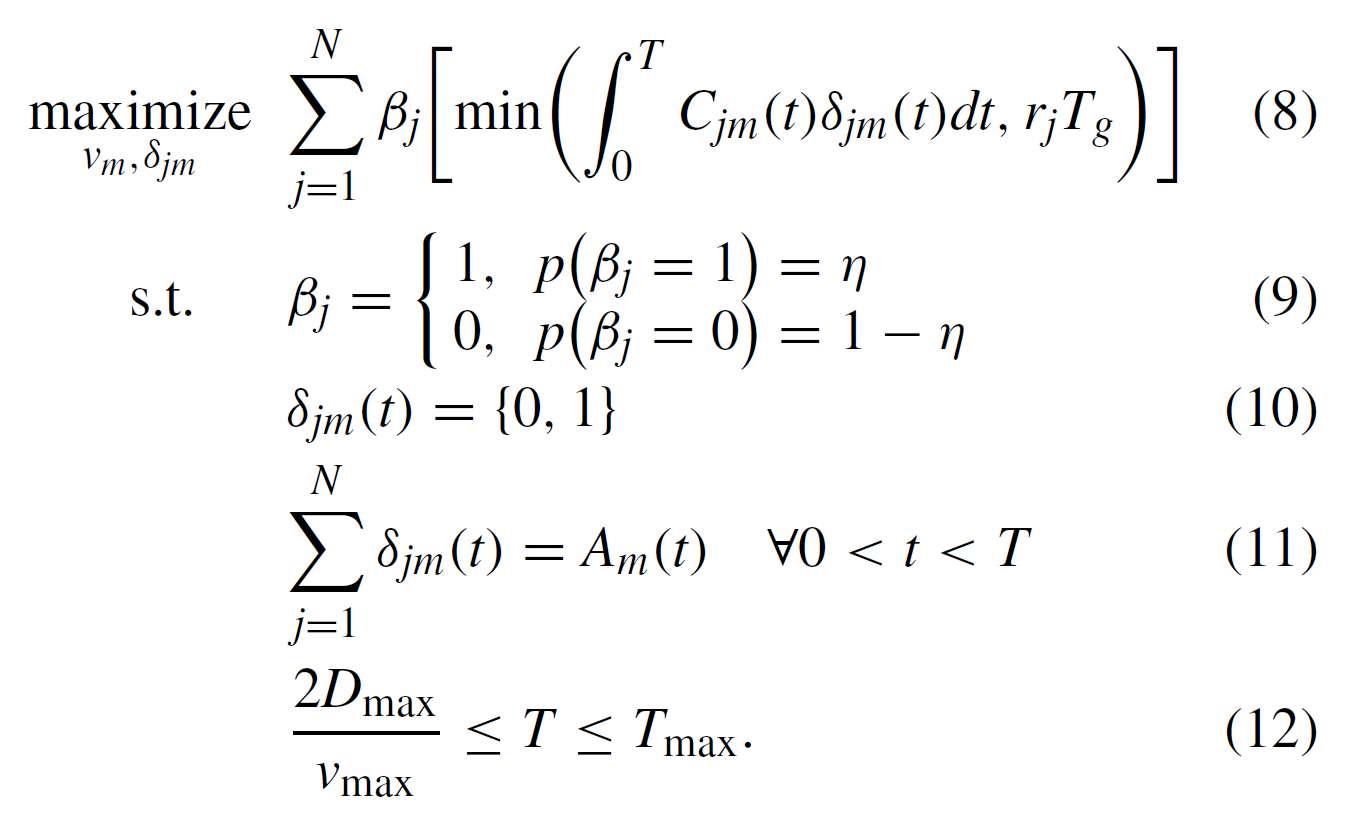
- \(r_j\) = data generation rate of sensor \(j\)
- 2 states of WSN → (9)
- active gathering state
- probability = \(\eta\)
- \(\beta_j=1\)
- silent listening state
- probability = \(1-\eta\)
- \(\beta_j=0\)
- active gathering state
- \(\delta_{jm}(t)\) = 1 iff sensor \(j\) is uploading data to UAV \(m\) at time \(t\) → (10)
- sum = num of sensors simultaneously uploading to UAV \(m\) → (11)
- es el strategy of uploading
- hard to obtain strategies of other sensors & flight mode of UAV → difficult to make this strategy
- limited path & time for UAV → mutual interference among ground sensors
- UAV 不能在 WSN 範圍待太久 → (12)
with clustering¶
 - ground sensors have incentive to form data cluster when they want to upload at the same time to the same UAV
- assume \(jm\) link is better than \(im\) link, and they want to upload at the same time
- sharing the bandwidth will make \(j\) uploads slower, therefor, if the fast \(j\) help the slow \(i\) to upload its data with its high speed, both will be better off
-
- ground sensors have incentive to form data cluster when they want to upload at the same time to the same UAV
- assume \(jm\) link is better than \(im\) link, and they want to upload at the same time
- sharing the bandwidth will make \(j\) uploads slower, therefor, if the fast \(j\) help the slow \(i\) to upload its data with its high speed, both will be better off
- 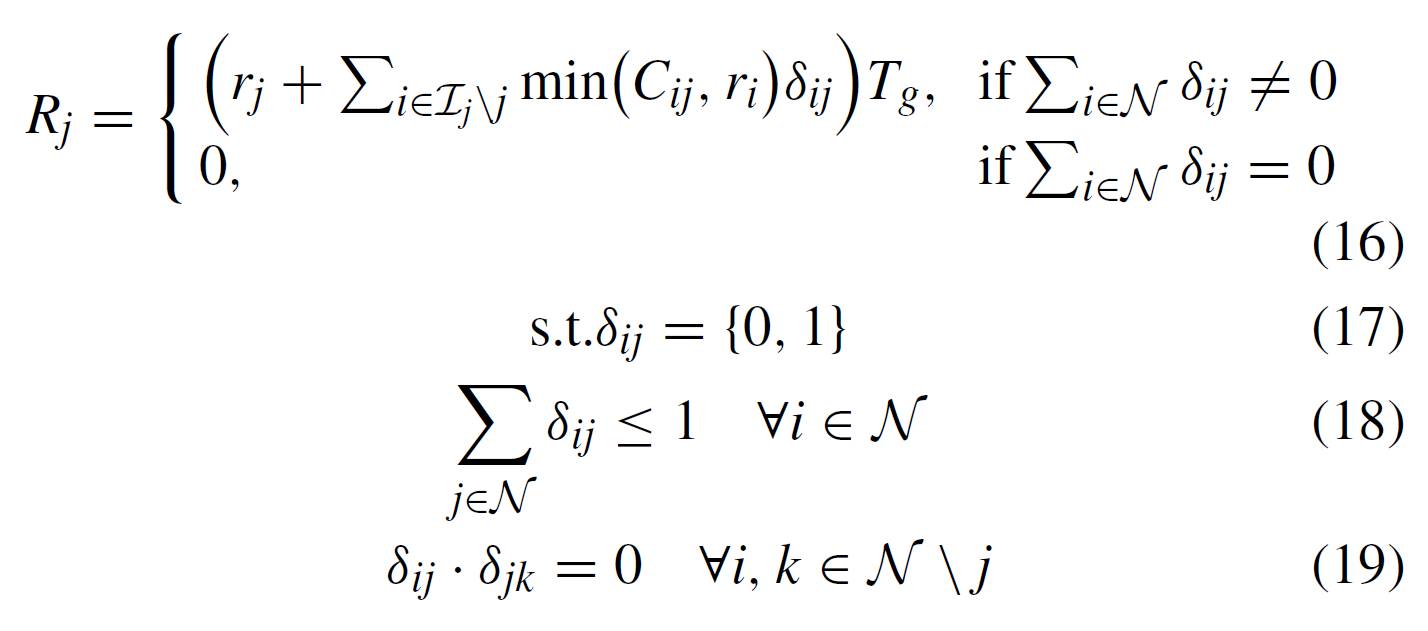 - \(R_j\) is the gathered data, the total data needed to be uploaded by cluster head \(j\)
- including all its members' data
- \(\delta_{ij}\) = \(i\) connects to cluster head \(j\) (binary variable)
- a sensor can only be in one cluster at max → (18)
- a sensor can't be both cluster head & member → (19)
-
- \(R_j\) is the gathered data, the total data needed to be uploaded by cluster head \(j\)
- including all its members' data
- \(\delta_{ij}\) = \(i\) connects to cluster head \(j\) (binary variable)
- a sensor can only be in one cluster at max → (18)
- a sensor can't be both cluster head & member → (19)
-  - if i belongs to j, it won't upload when UAV pasts it
-
- if i belongs to j, it won't upload when UAV pasts it
-  - if i doesn't belong to others, it would be a cluster head and upload data when UAV pasts it
- if i doesn't belong to others, it would be a cluster head and upload data when UAV pasts it
coalition game¶
reliable LoS transmission¶
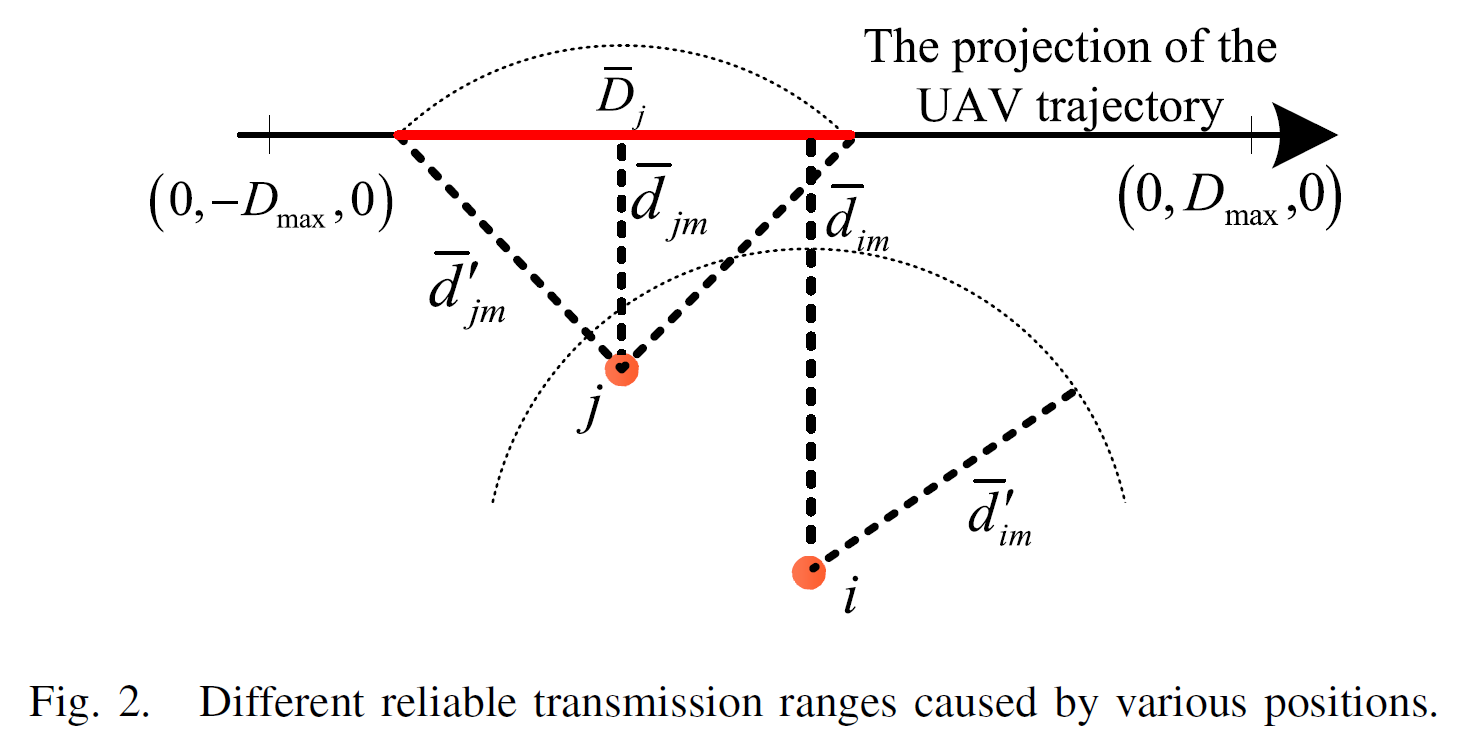
- \(\bar{D_j}\) = UAV 飛在 j 範圍內的總長
- 3 flight modes
- hovering mode
- max uploading data
- max velocity mode
- min uploading data
- normal velocity mode
- general case
- conventional flight mode
- constant velocity of \(\bar{v}=2D_{max}/T_{max}\)
- effective transmittion time \(T_j'\) =

- UAV 飛在 j 範圍內的總時
- hovering mode
- ground sensor near UAV trajectory will help others upload data when its capacity is better than what it needs itself
- when total gathering data \(R_j\) > capacity \(R_j'\), transmission reliability \(f_R(j)\) decays exponentially
- when total gathering data \(R_j\) > capacity \(R_j'\), transmission reliability \(f_R(j)\) decays exponentially
transmission correlation¶
- ideal data uploading range
- j will upload data when y coordinate \(\in \tilde{D_j}\)
- \(\tilde{D_j}\) changes with cluster situation
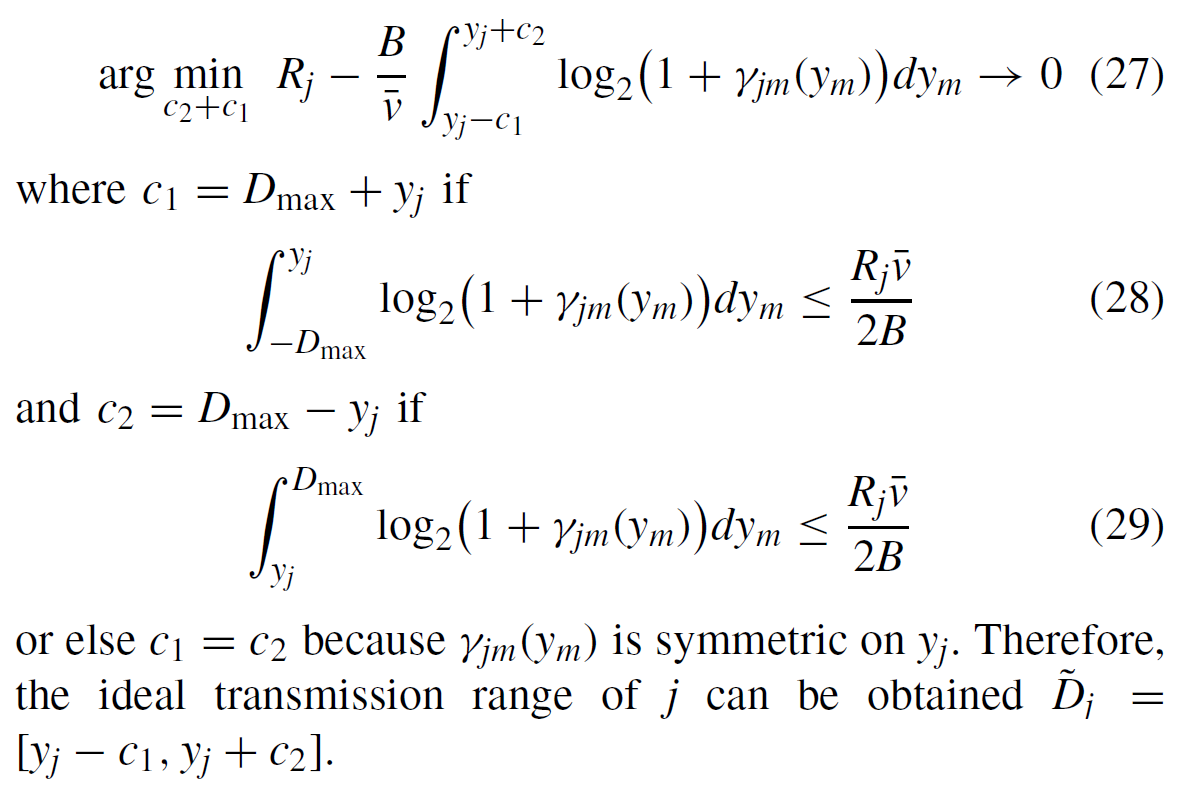
- transmission correlation \(\zeta(i,j)\) = inteference between \(i\) & \(j\)
- when \(i\) & \(j\)'s uploading data range overlaps, they might cause interference to each other's uploading
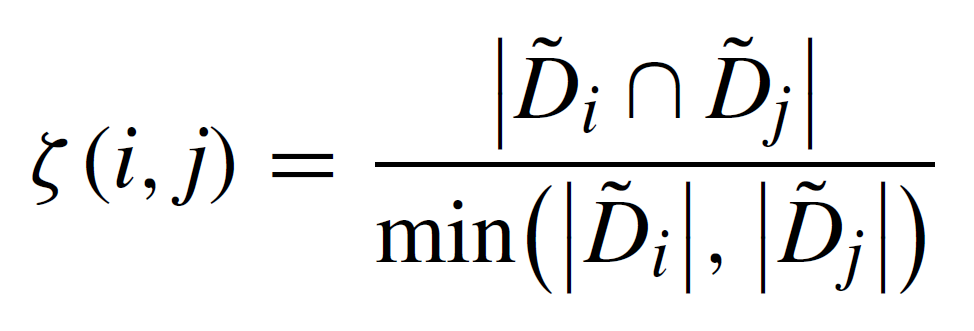
- clustering & offloading data to sensors closer to UAV trajectory will then stop its interference to others
coalition formation game model¶
- utility of sensor i
\(u_i(a_i,a_{-i})=f_R(a_i)\zeta(i,a_i)min(C_{ia_i},r_i)\)- \(a_i\) = \(i\)'s cluster selection strategy
i.e. who \(i\) choose to offload to
i.e. \(i\)'s cluster head - \(a_{-i}\) = others' cluster selection strategy
- \(f_R(a_i)\) = \(i\)'s cluster head's transmission reliability
- \(\zeta(i,a_i)\) = interference between \(i\) & \(i\)'s cluster head
- \(min(C_{ia_i},r_i)\) = data gathering rate
- generation rate capped by transmission rate
- \(a_i\) = \(i\)'s cluster selection strategy
- a sensor can select 1 coalition at most
pareto-based preference criterion¶
basically, do the operation iff the subject of the operation is better off && everyone else isn't worse off (pareto) after the operation
- switch
- sensor \(i\) switch coalition iff sensor \(i\) is better off after the switch && everyone in the 2 coalitions isn't worse off after the switch
-  - merge
- 2 coalitions merge iff total utility is greater after the merge && everyone in the 2 coalitions isn't worse off after the merge
-
- merge
- 2 coalitions merge iff total utility is greater after the merge && everyone in the 2 coalitions isn't worse off after the merge
-  - split
- a coalition splits iff total utility is greater after the split && everyone in the coalition isn't worse off after the split
-
- split
- a coalition splits iff total utility is greater after the split && everyone in the coalition isn't worse off after the split
-  - exchange
- 2 non-head sensors in different coalitions exchange coalitions iff they're both better off after the exchange && everyone in the 2 coalitions isn't worse off after the exchange
-
- exchange
- 2 non-head sensors in different coalitions exchange coalitions iff they're both better off after the exchange && everyone in the 2 coalitions isn't worse off after the exchange
-  - equilibrium
- every sensor wouldn't find a better coalition to join (only considering itself)
-
- equilibrium
- every sensor wouldn't find a better coalition to join (only considering itself)
-  - at least one stabe coalition structure
- strategies are limited
- all operations are monotonic
- each operation contributes to the total utility
-
- at least one stabe coalition structure
- strategies are limited
- all operations are monotonic
- each operation contributes to the total utility
-  - so it will eventually converge to a coalition equilibrium structure
- so it will eventually converge to a coalition equilibrium structure
algorithm¶
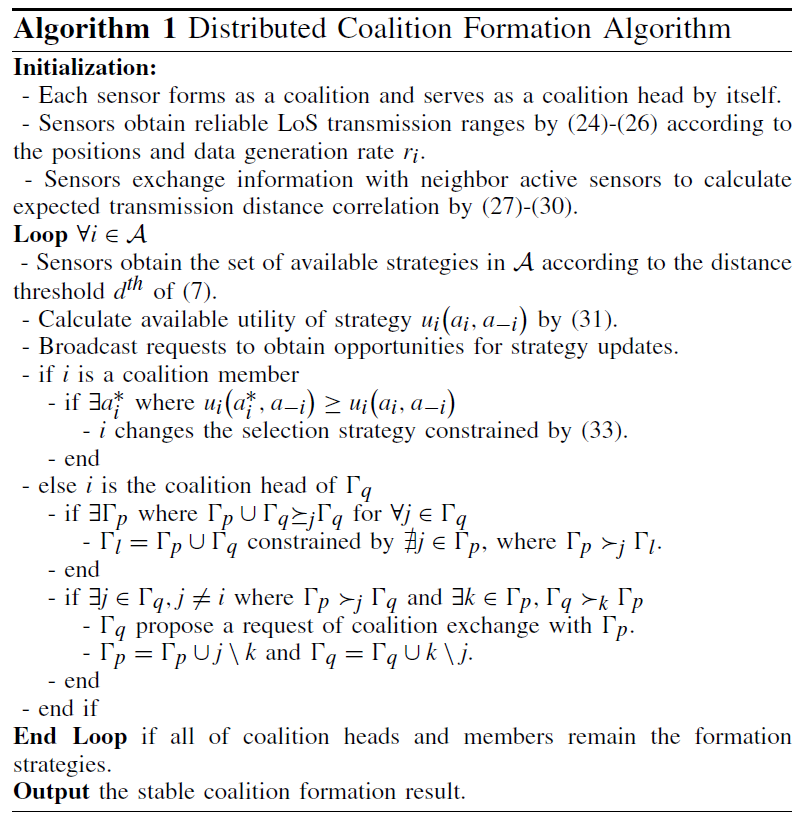
- for coalition members
- switch operation
- directly updates its coalition selection policy
- each sensor only needs to interact with coalition head to meet the pareto criterions
- bc sensor performance is a function of cluster head's transmission reliability
→ if \(f_R(j)\) unchanged, the pareto criterion is satisfied
- bc sensor performance is a function of cluster head's transmission reliability
- switch operation
- for coalition heads
- merge & exchange operation
- split operation can be covered with members departure & exchange, so not separately calculated
- \(O(C_1+2(\eta N-1)+C_2)\) each strategy updates
- \(\eta\) = probability of sensors to update active states
UAV online flight control¶
- network topology & coalition formation unknown → UAV can't plan flight status in advance
transmission protocol¶
- problems to solve
- equilibrium of coalitions doesn't guarantee no interference
- coalitions can't obtain all strategies of other coalitions
- increase gathered data → increase transmission range → more likely to affect other coalitions
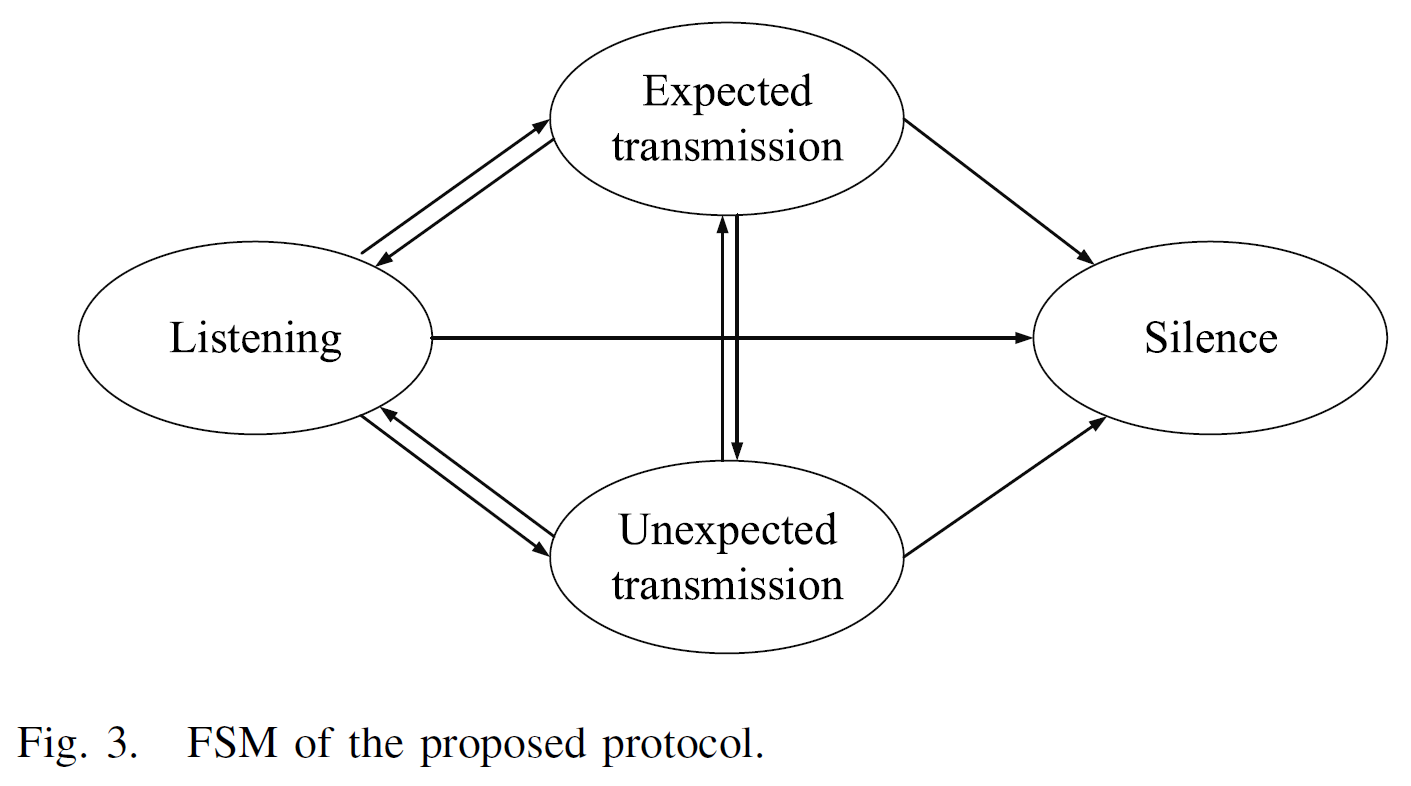
- UAV continuously broadcasts its position & transmission status during flight, and coalition heads initialize in listening state
- the coalition head closest to UAV will be allowed for transmission, while others remain in listening
- if UAV isn't actually in the transmission range, the coalition head will go to unexpected transmission state
- otherwise, it goes to expected transmission state
- one at a time, siempre
- having upload all the gathered data, sensors will go to silence state
UAV flight mode¶
- given a trajectory, adjust the flight speed
passive data collection¶
- doesn't detect any ground network status
- fix to normal speed \(v_m=\dfrac{2D_{max}}{T_{max}}\)
partially detectable system¶
- receive data upload requirement of ground sensors
- 3 processes
- estimating
- receives data uploading requests from ground sensors
- find the max transmission efficiency \(\gamma_{jm}'\) of all detectable coalitions
- flying
- fly to the optimum transmission position of the nearest coalition head in max speed \(v_{max}\)
- hovering
- hovers at the optimum transmission position, receives data
- flight time threshold
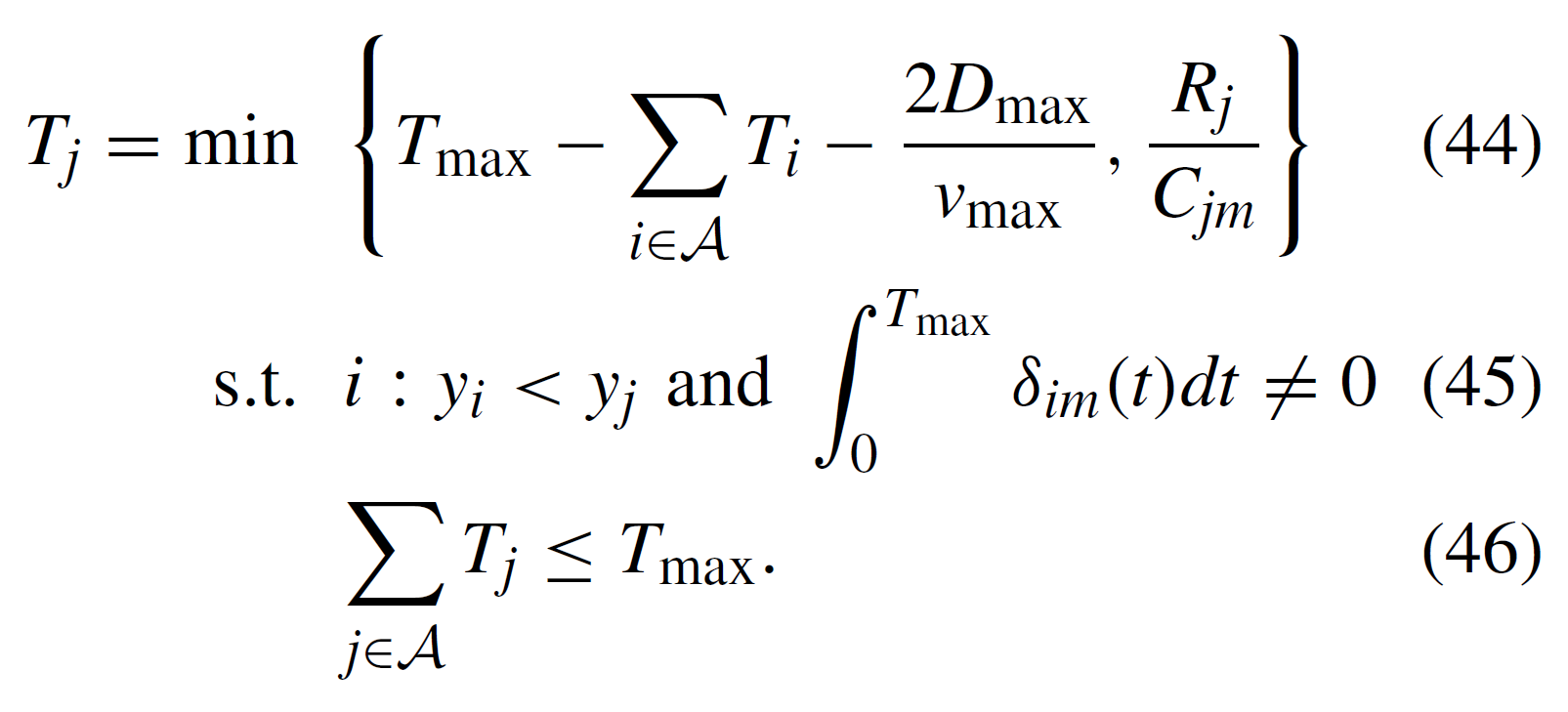
- estimating
- remaining transmission time difficult to estimate
- transmission time affects later coalitions
fully detectable system¶
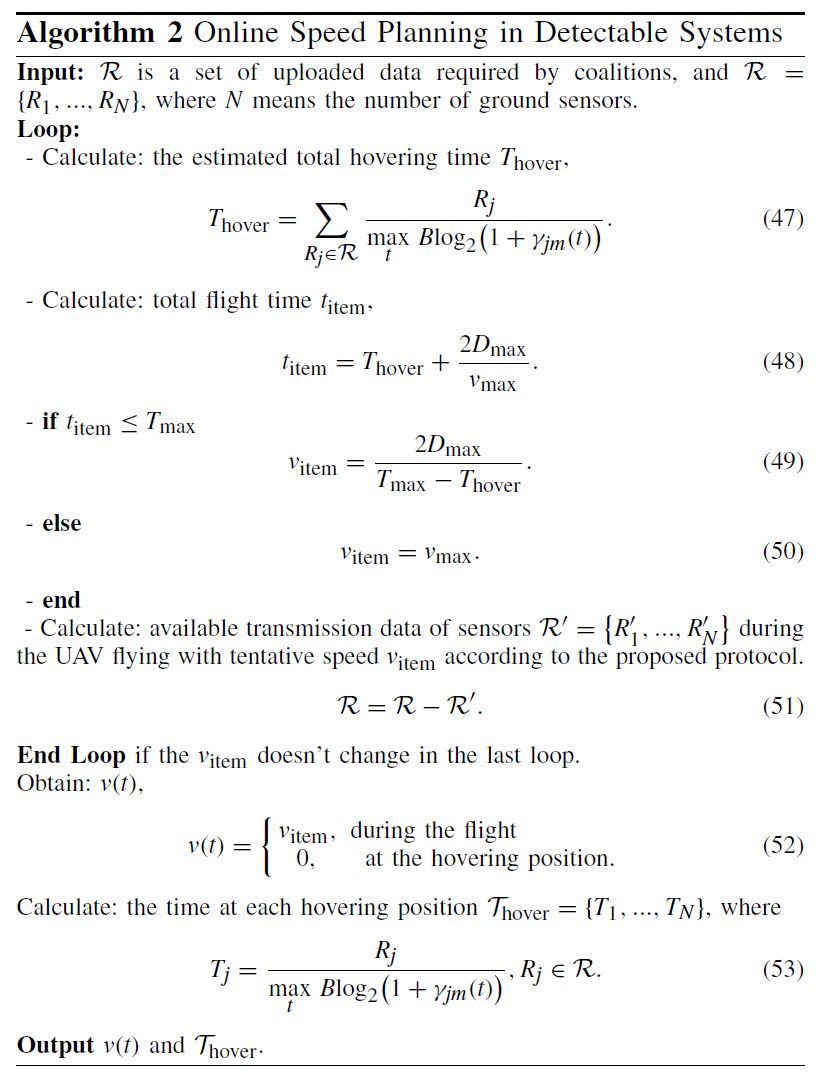
- detect all the coalition strategy states
- estimate transmission efficiency at different locations
- obtain optimal flight speed & hovering time in the entire network through the algorithm
simulation results¶
- parameter settings
- forming coalitions
- UAV flight mode
- if not specified,
- \(N=40\)
- \(\eta=0.8\)
- \(T_{max}=400s\)
- \(p_j=0.1W\)
- \(P_{LoS}'=0.6\)
collected data vs. number of sensors¶
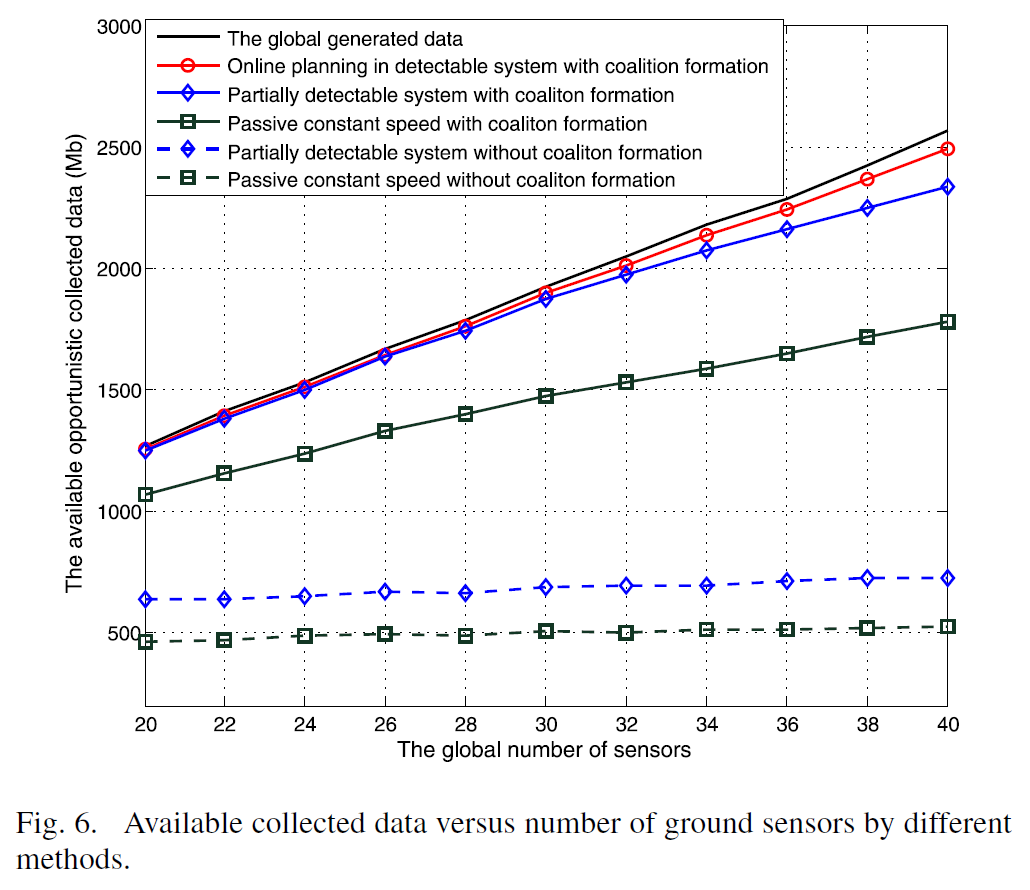
- without coalition, collected data doesn't increase with the increase of ground sensors
- UAV has limited flight time
- with coalition, collected data is closed to data gathered
collected data vs. sensors' active rate¶
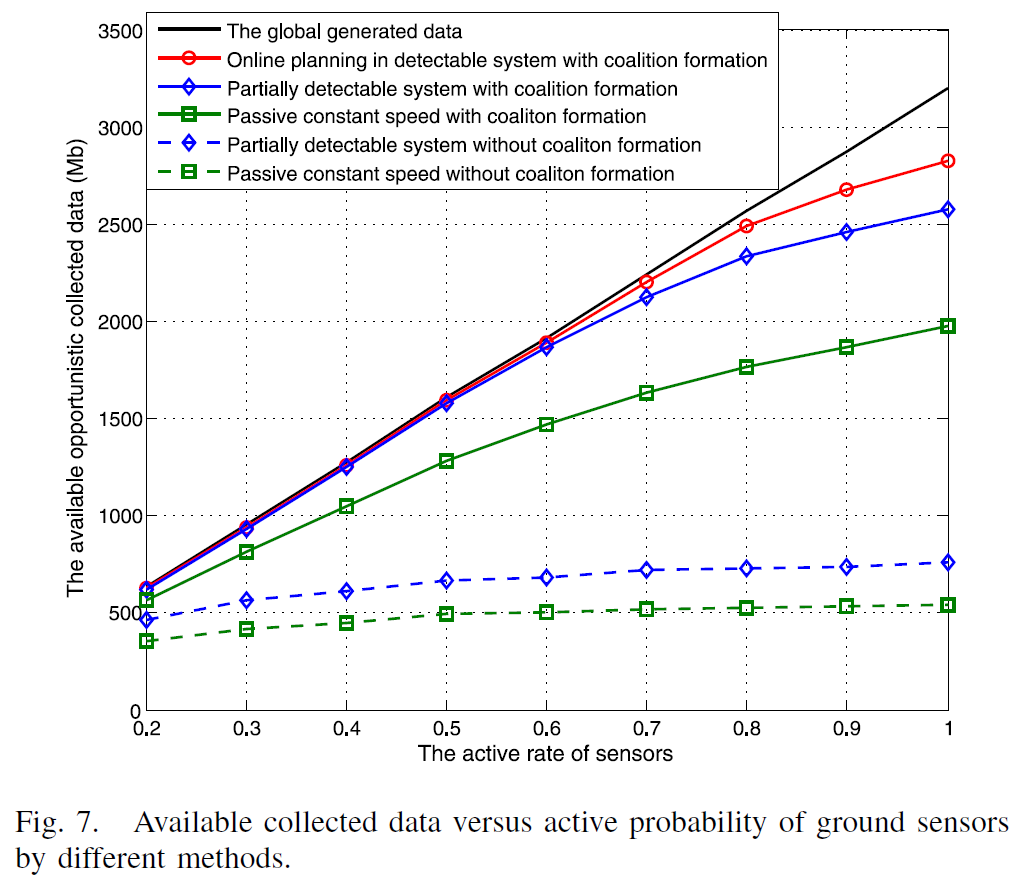
- active rate = probability of being in active state (as opposed to silent state)
- limited UAV capability → the gap from collected data to gathered data increase with the increase of active rate
collected data vs. flying time constraint¶
collected data vs. sensors' transmission power¶
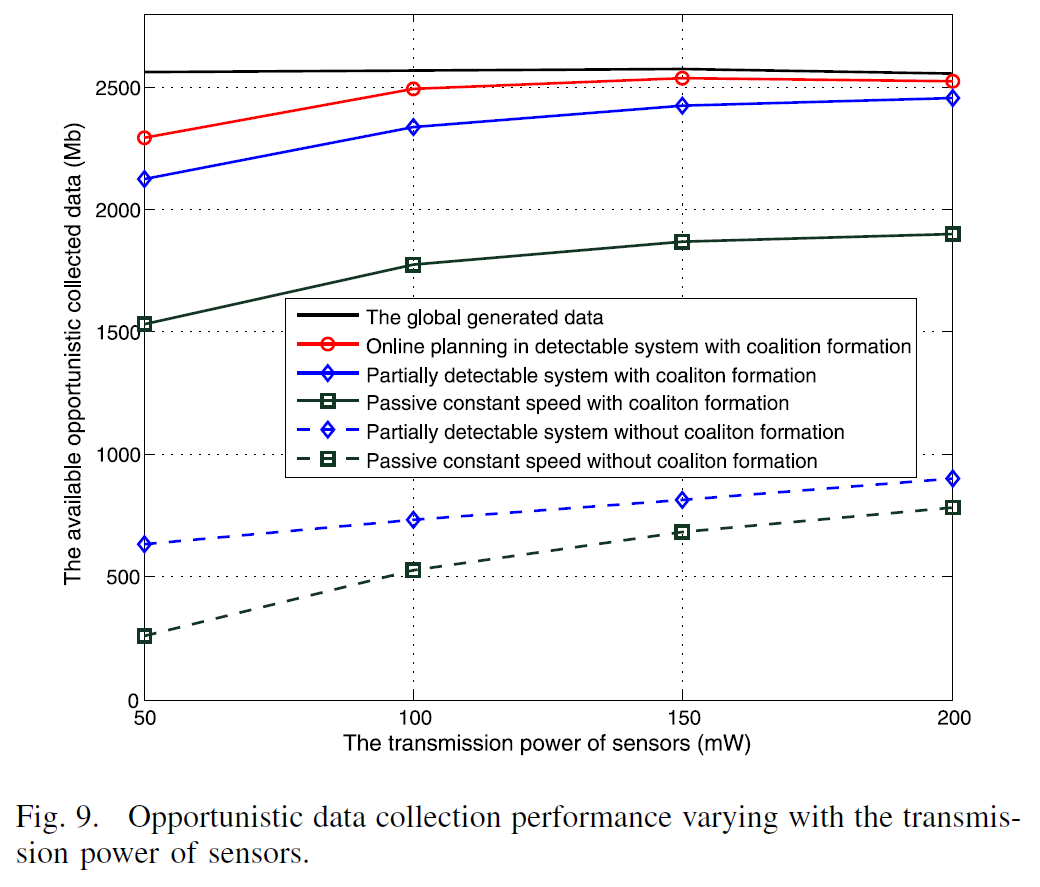
- more transmission power → larger transmission range → more upload on its own → more interference → marginal improvement decreases
collected data vs. transmission reliability threshold¶
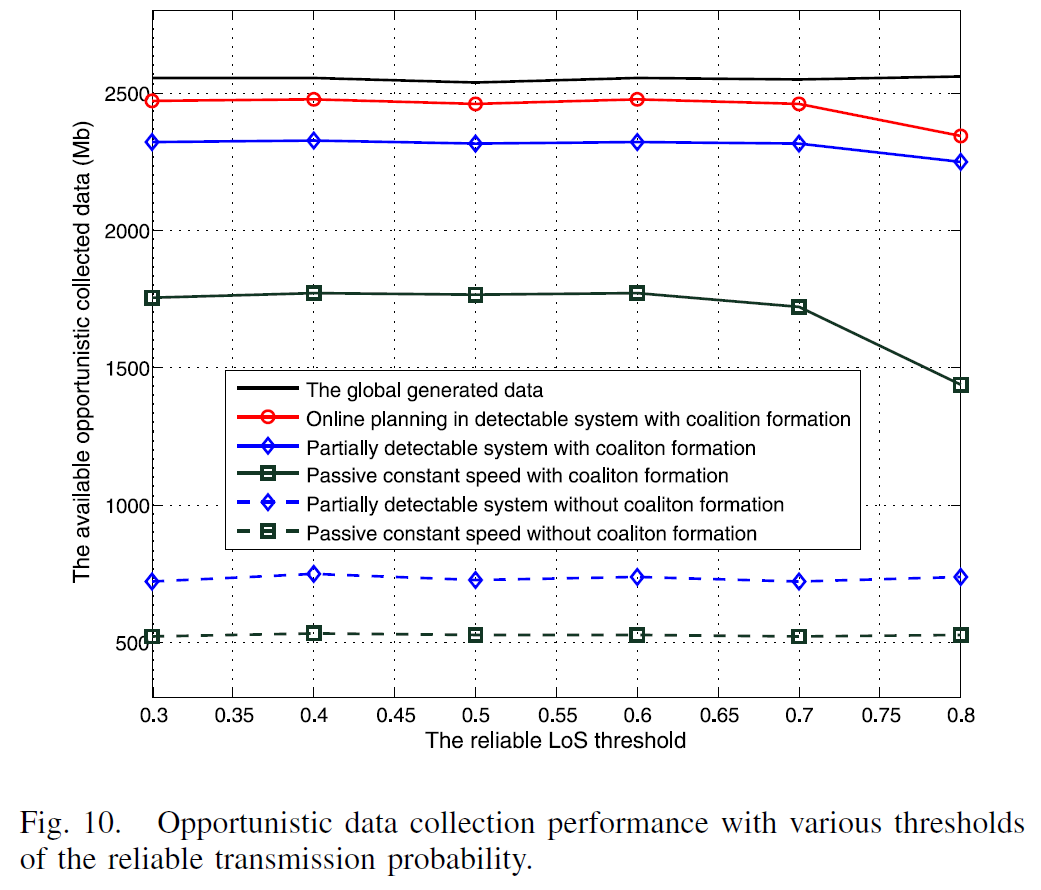
- transmission reliability < threshold → can't be coalition head
- lower threshold → more options (still the nearest to the UVA trajectory would be selected, so below 0.7 the coalition formation is always the same)
- but more options mean more information interaction between sensors → \(P_{LoS}'=0.7\) is optimal
convergence¶
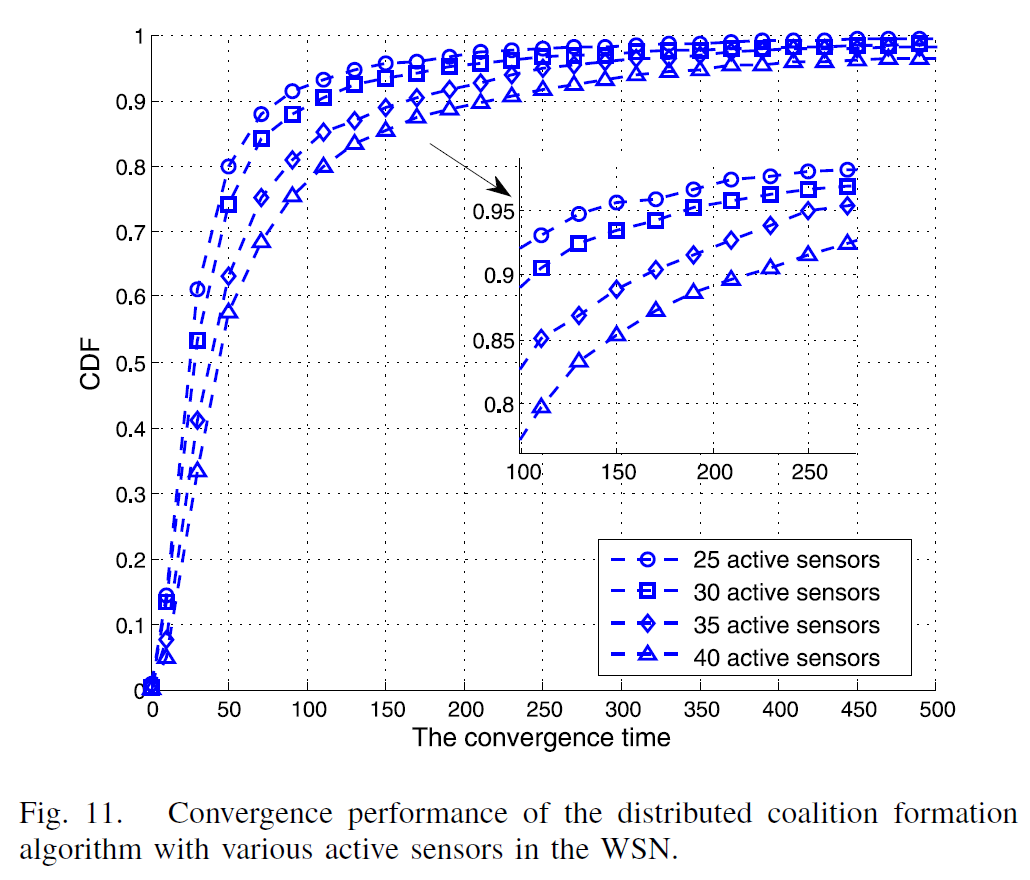
It converges!
conclusion¶
- air-ground combined online optimization >> unilateral data collection of UAV
- UAV flight planning improves the data uploading efficiency
comments¶
Making a friend is better than making an enemy.


